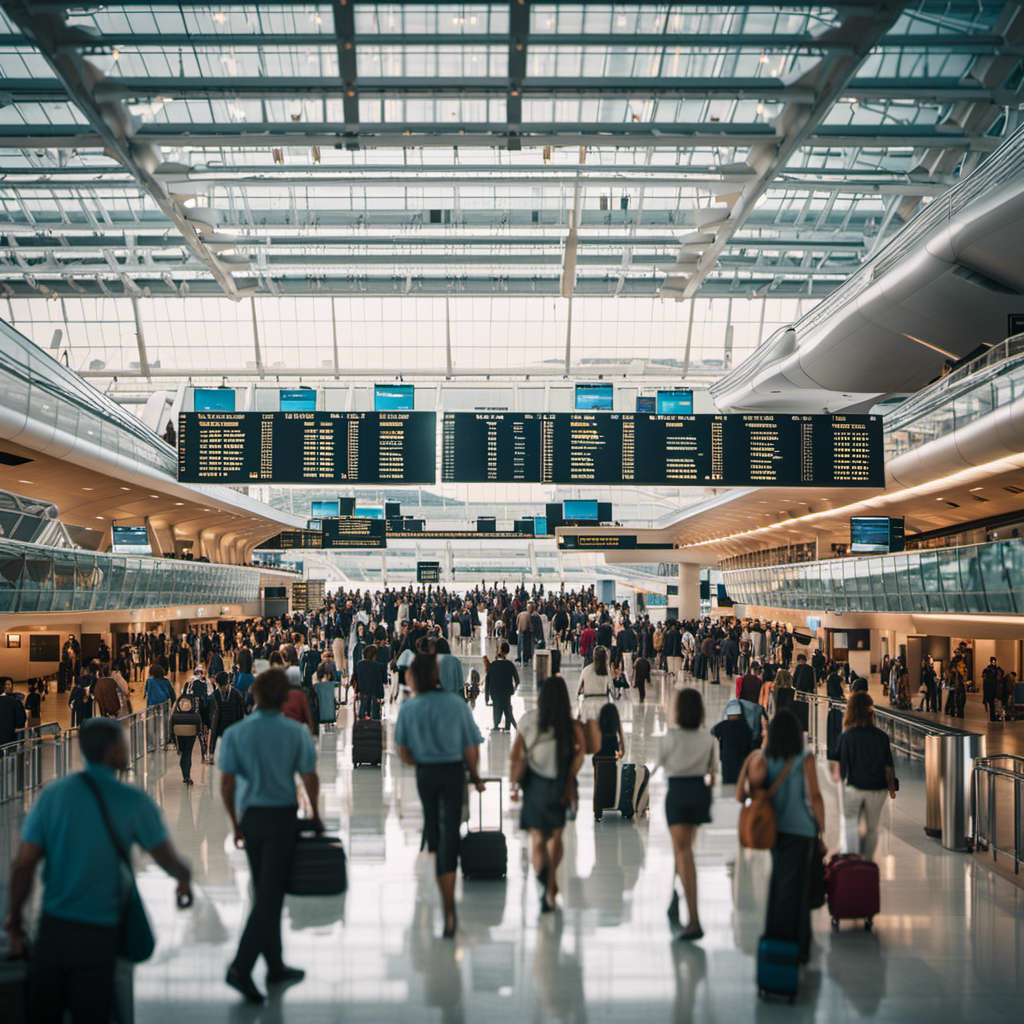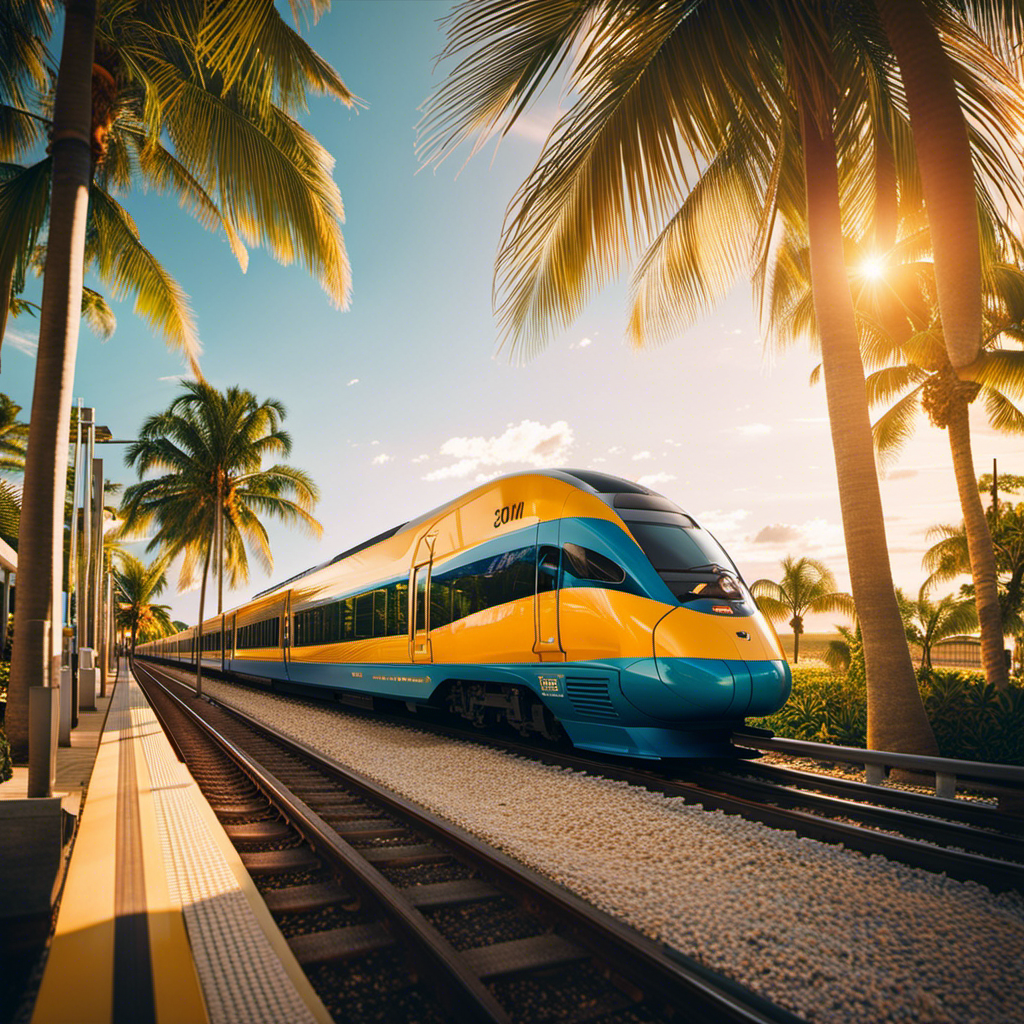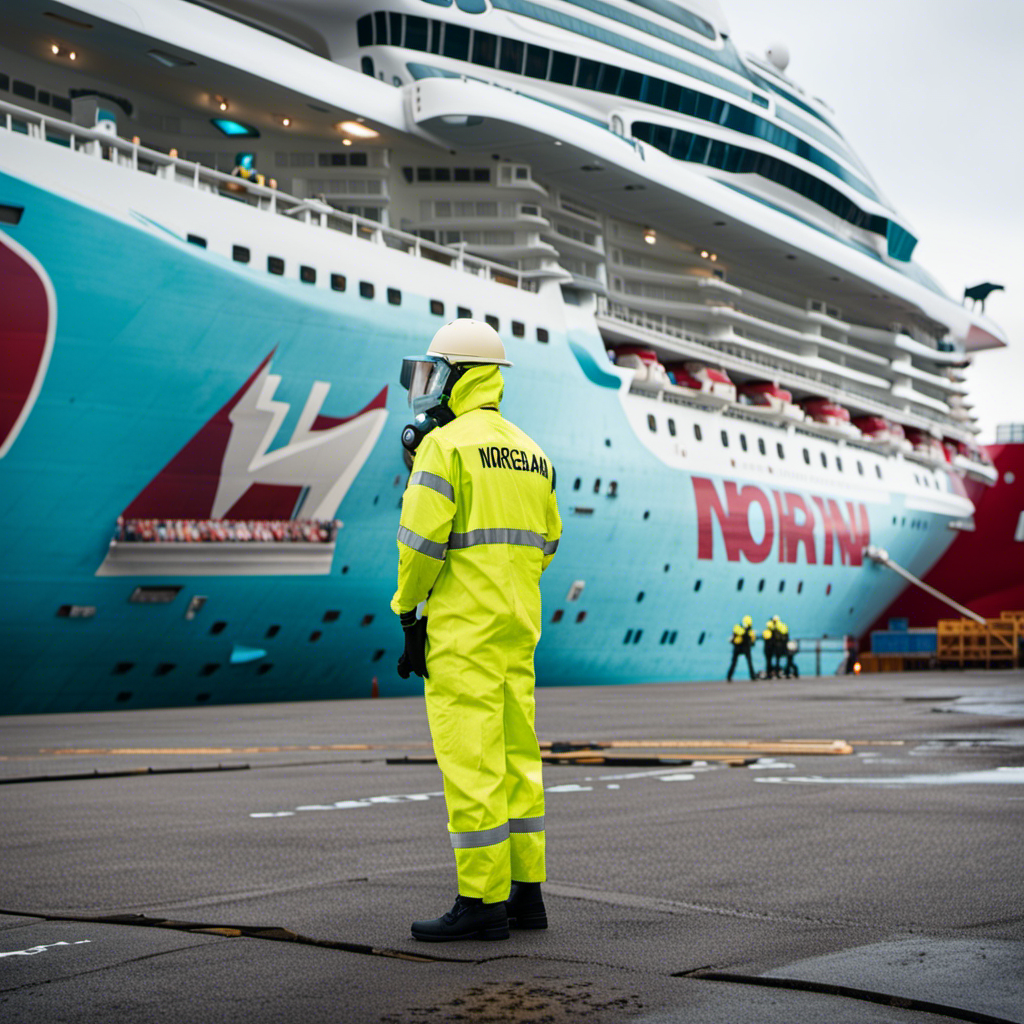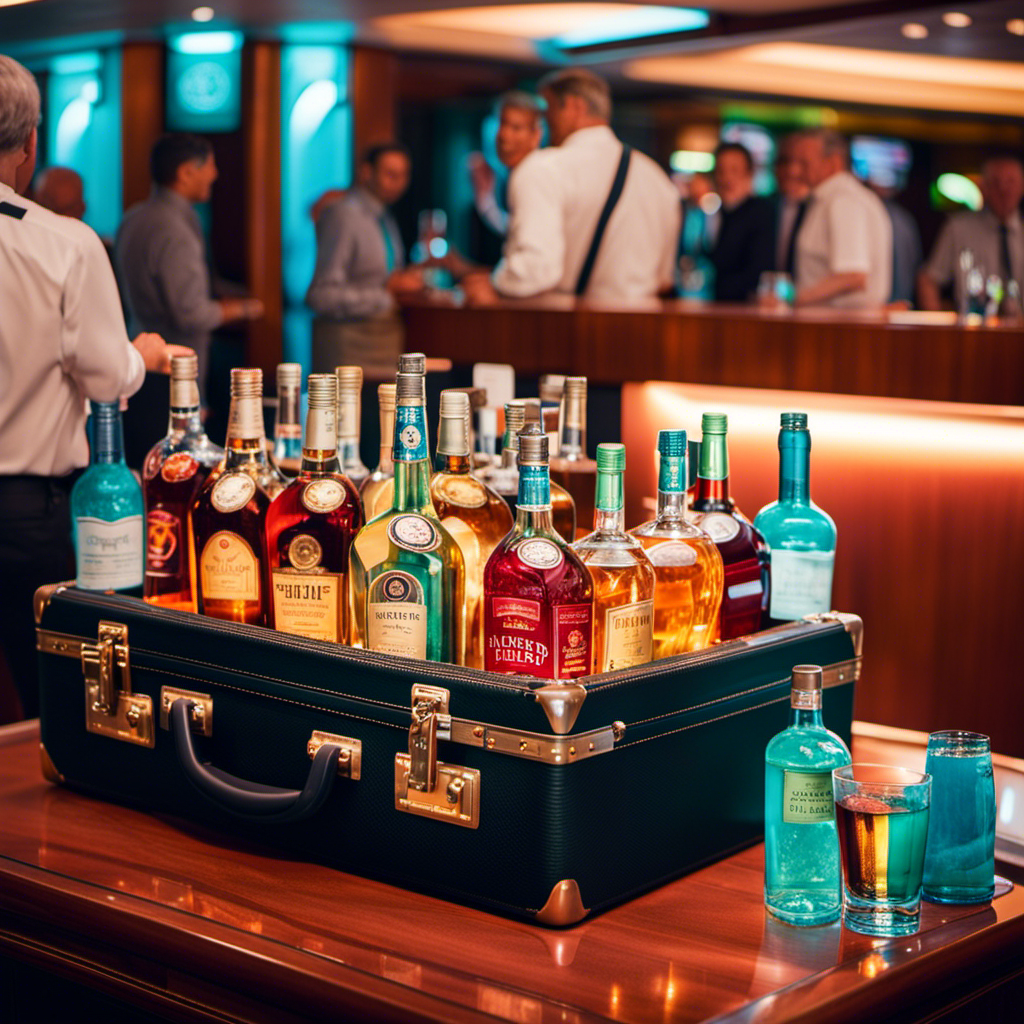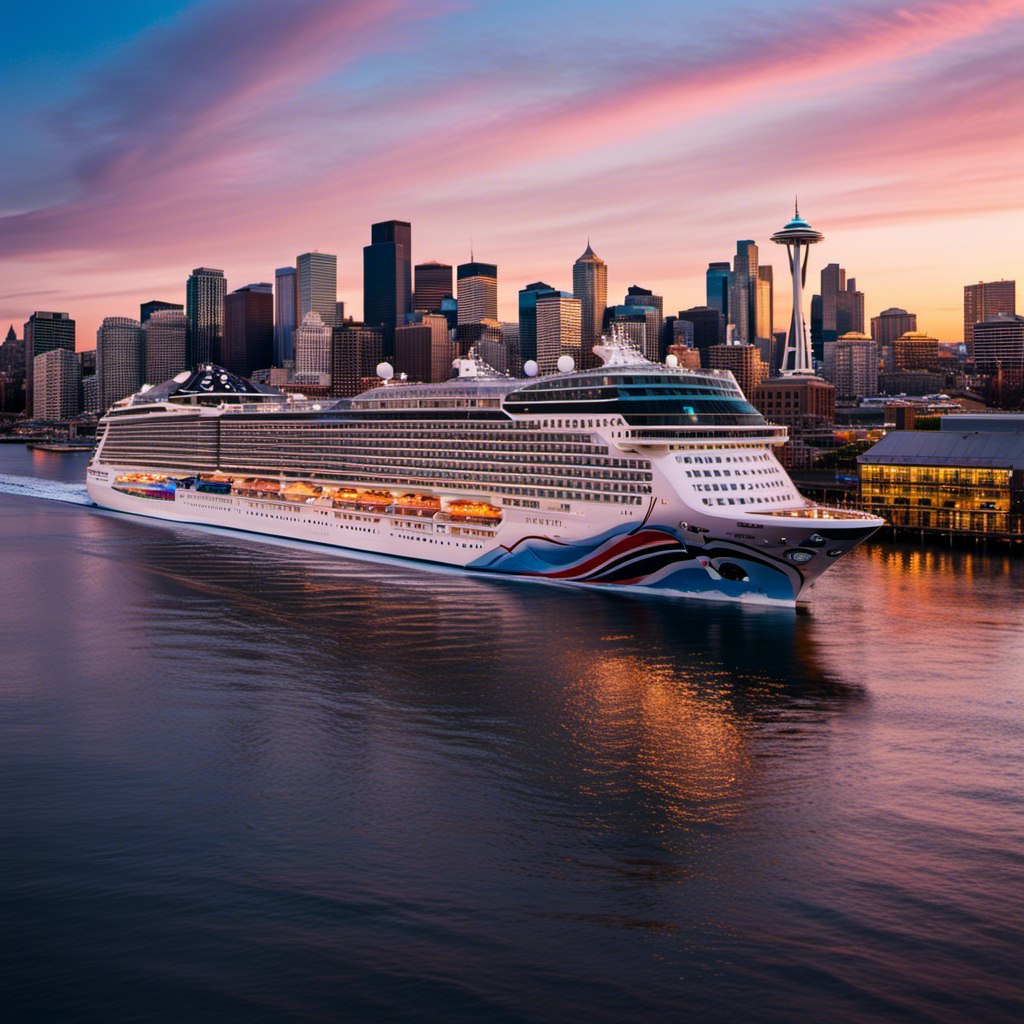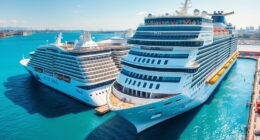As a seasoned cruiser, I’ve learned the importance of carefully planning flights after disembarking from a cruise ship.
Picture this: you’ve just had an incredible vacation, but now it’s time to head home. It’s crucial to plan your flight no earlier than 5 hours after the ship docks to allow for the boarding and debarkation processes, which can vary in duration.
With potential delays caused by ship clearance, customs/immigration checks, and long lines during debarkation, it’s wise to give yourself a time cushion.
Let me share some tips and experiences to help you make informed decisions about flight timing after your cruise.
Key Takeaways
- Schedule flights no earlier than 5 hours after the ship docks to allow for boarding and debarkation processes.
- Consider potential delays caused by ship clearance, customs/immigration checks, and long lines during debarkation.
- Choose assigned debarkation time to potentially shorten lines and expedite the process.
- Factor in travel time to the airport, especially for ports located far from major airports, and allow for buffer time to avoid stress and potential delays.
Timing Consideration: Schedule Flight No Earlier Than 5 Hours After Ship Docks
I shouldn’t schedule my flight any earlier than 5 hours after the ship docks to account for potential delays and the debarkation process. It’s important to give yourself enough time to navigate through any unexpected issues that may arise.
However, there are exceptions to consider. On boarding days, it’s best to avoid scheduling a flight too early as the boarding process can take longer if you arrive early. On debarkation days, the process can be even more time-consuming, with long lines and waits. Ship clearance and customs/immigration checks can also cause delays. While self-assist debarkation allows passengers with all their luggage to leave first, the lines can still be long. Selecting an assigned debarkation time can result in shorter lines.
In general, it’s best to err on the side of caution and schedule your flight no earlier than 5 hours after the ship arrives, with an absolute minimum of 3 hours before the ship returns. Keep in mind that ports with longer distances to major airports may require more time. Having a time cushion is crucial in case of any unexpected issues.
Exceptions to Consider: Allowing for Earlier Flights After a Cruise
Arriving at the port early may result in a longer boarding process. However, there are exceptions to consider when it comes to allowing for earlier flights after a cruise. Here are some key points to keep in mind:
-
Itineraries: Some cruise itineraries may allow for an earlier departure, especially if the ship arrives early at the port.
-
Self-Assist Debarkation: Opting for self-assist debarkation can give you the flexibility to leave the ship earlier, as you can carry all your luggage with you.
-
Port Distance: If the cruise port is closer to the airport, you may have more time to catch an earlier flight.
In my experience, I’ve been able to catch earlier flights after a cruise by taking advantage of these exceptions. However, it’s important to always check with the cruise line and consider any potential delays or unexpected issues before finalizing your flight plans.
Different Time Requirements: Boarding and Debarkation Days
When planning my itinerary, it is important to note that boarding and debarkation days have different time requirements. The boarding process can take longer if I arrive early, as there may be more people in line ahead of me. On the other hand, the debarkation process can be more time-consuming than boarding, especially if there are long lines and waits. Ship clearance and customs/immigration checks can cause delays during debarkation. However, there are some strategies I can use to minimize the time spent during these processes. For example, opting for self-assist debarkation allows me to leave the ship first with all of my luggage. Selecting an assigned debarkation time may also result in shorter lines. It is important to consider these time requirements when planning my flight after a cruise to ensure a smooth and stress-free transition.
| Boarding Process | Debarkation Process |
|---|---|
| Can take longer if arriving early | More time-consuming than boarding |
| Longer lines and waits are possible | Ship clearance and customs/immigration checks cause delays |
| Opting for self-assist debarkation allows passengers to leave first | Selecting assigned debarkation time can result in shorter lines |
Keywords: boarding process, debarkation process.
Boarding Process: Potential Delays When Arriving Early
Opting for an early arrival at the boarding process can lead to potential delays due to longer lines and waits. When you arrive early, you may find yourself standing in line for a longer period of time, as there may be fewer staff members available to assist with the check-in process.
Additionally, if you arrive before the designated boarding time, you may end up waiting in a crowded waiting area with limited seating.
To make matters worse, early arrivals can also result in longer waits to board the aircraft. Airlines typically have a set boarding process, with different groups called to board at specific times. If you arrive too early, you may find yourself waiting in line for your group to be called, while watching other passengers board ahead of you.
Debarkation Process: Long Lines and Waits to Leave the Ship
I found that the debarkation process can involve long lines and waits, which can be frustrating for passengers. After enjoying a relaxing cruise, the last thing you want is to be stuck in a crowded terminal, anxiously waiting to leave the ship. Customs and immigration checks are the main culprits behind these long waits. As passengers disembark, they are required to go through these checks, which can take time, especially if there are a large number of people on board. To give you a better idea of what to expect, here’s a table showcasing the potential wait times during the debarkation process:
| Wait Time | Reason | Tips to Minimize Wait Time |
|---|---|---|
| 1-2 hours | Customs/Immigration checks | Have necessary documents ready and easily accessible |
| 30 minutes | Ship clearance | Opt for self-assist debarkation if you have all your luggage with you |
| 1-2 hours | Exiting the ship and queuing for customs/immigration | Choose an assigned debarkation time for shorter lines |
Navigating the debarkation process can be challenging, but with some patience and preparation, you can minimize the impact of these long waits and ensure a smooth transition from the ship to your next destination.
Time-Consuming Debarkation: Comparing It to the Boarding Process
Navigating the debarkation process can be time-consuming, as it usually involves longer lines and waits compared to the boarding process. However, knowing what to expect and preparing for potential delays can help make the experience smoother. Here’s a comparison between the debarkation and boarding processes:
- Checking out of the ship: This step involves going through ship clearance and customs/immigration checks, which can cause delays.
- Self-assist debarkation: Passengers with all their luggage can choose to leave the ship first, but the lines for this option can be long.
- Assigned debarkation time: Selecting a specific time to leave the ship can result in shorter lines.
To prepare for debarkation delays, consider the following tips:
- Allow at least 5 hours before scheduling a flight after the ship arrives.
- Factor in potential delays due to weather conditions or a large rush of people.
- Have a passport to save time during customs/immigration checks.
Ship Clearance and Customs/Immigration Checks: Causes of Delays
Arriving at the cruise port, ship clearance and customs/immigration checks are necessary but can cause delays. These processes are essential for ensuring the safety and security of passengers and the port. However, they can be time-consuming, especially during peak travel times.
Thankfully, advancements in technology, such as facial recognition technology, have helped to expedite these checks. Additionally, having a passport can significantly benefit you during customs/immigration checks. Passports provide a standardized form of identification and streamline the verification process. They also provide proof of citizenship, which can simplify the entry requirements in certain countries.
Self-Assist Debarkation: Leaving the Ship With All Luggage First
Leaving the ship with all my luggage first, I can save time during the debarkation process and avoid long lines. Self-assist debarkation offers efficiency and convenience for passengers who are ready to depart immediately.
To prepare for self-assist debarkation, it is important to pack strategically and organize logistics. Here are some tips to make the process smoother:
-
Packing: Ensure that all your belongings are easily accessible and packed in a way that allows for quick retrieval. Use packing cubes or separate bags to keep items organized.
-
Luggage Tags: Attach clear and visible luggage tags with your contact information to easily identify your bags among a sea of luggage.
-
Documentation: Keep your passport, identification, and necessary travel documents easily accessible in a secure and easily accessible location.
-
Timing: Plan to be ready to disembark early to secure a spot in the self-assist debarkation line. Arriving too late may result in longer waits.
Long Lines for Self-Assist Debarkation: Faster but Potentially Lengthy
While self-assist debarkation offers a faster process, the long lines can still make it a potentially lengthy experience. It’s important to be aware of the potential delays that can occur with self-assist debarkation.
While it may seem like the fastest option for leaving the ship with all of your luggage, there can be significant wait times due to the large number of passengers opting for this method. The lines can be quite long, especially during peak times, and it’s not uncommon to wait for an extended period before being able to disembark.
It’s important to factor in these potential delays when planning your post-cruise travel arrangements and allow for extra time to ensure you don’t miss your flight or other transportation connections.
Assigned Debarkation Time: Shorter Lines for Smoother Departure
I found that selecting an assigned debarkation time resulted in shorter lines and a smoother departure from the ship. Here are some reasons why it’s worth considering:
- Assigned debarkation time allows for a more organized and efficient departure process.
- By selecting a specific time, you can avoid the chaos and long lines that can occur during self-assist debarkation.
- The ship’s staff can better manage the flow of passengers, ensuring a smoother transition from the ship to the terminal.
I highly recommend taking advantage of the assigned debarkation time option. It not only saves you time and frustration but also allows for a more enjoyable end to your cruise experience.
Minimum Flight Timing: No Earlier Than 5 Hours After Ship Arrives
Arriving at the airport no earlier than 5 hours after the ship docks allows for a smoother transition from the cruise to the flight. However, there may be exceptions that allow for earlier flights, depending on various factors.
There are several factors that can affect departure delays after a cruise. Weather conditions, especially fog, can cause delays, as well as a large rush of people leading to longer debarkation lines. Customs and immigration checks also add to the time needed to leave. Having a passport can save time during these checks.
It is important to consider these factors when choosing a flight time after a cruise. By allowing for a time cushion and considering potential delays, you can ensure a stress-free and smooth departure from your cruise.
Absolute Minimum: No More Than 3 Hours Before Ship Returns
When scheduling my flight, I need to make sure to allow for an absolute minimum of no more than 3 hours before the ship returns. It’s important to have a 3 hour buffer to account for any unexpected delays or issues that may arise during the debarkation process.
Early arrival considerations are also crucial in order to avoid any unnecessary stress or potential missed flights. While it may be tempting to schedule a flight earlier in order to get home sooner, it’s important to remember that the debarkation process can take longer than expected, especially if there are long lines or delays due to customs and immigration checks.
Therefore, it’s advisable to give yourself a comfortable time cushion and schedule your flight no earlier than 5 hours after the ship arrives, with the absolute minimum being no more than 3 hours before the ship returns.
Longer Distances to Airports: Considerations for Certain Ports
Port Canaveral and Galveston are known for their distance from major airports, requiring additional travel time when planning transportation after a cruise. When considering travel time, it’s important to take into account the distance between the port and the airport.
In the case of Port Canaveral and Galveston, the travel time can be longer compared to other ports. This means that you may need to allocate more time for shuttle services or pick-up arrangements. It’s advisable to book a shuttle service in advance to ensure a smooth and timely transfer to the airport.
Additionally, be aware of any potential traffic or delays that may occur along the way. By considering these travel time considerations and making appropriate shuttle services and pick-up arrangements, you can minimize stress and ensure a seamless transition from your cruise to your flight home.
Importance of Time Cushion: Preparing for Unexpected Issues
When it comes to planning your flight after a cruise, it’s crucial to have a contingency plan in place. Dealing with unexpected delays is a common occurrence, and having a time cushion can help alleviate stress and ensure a smooth transition from ship to airport.
From my own experiences, I’ve learned the importance of allowing for extra time in case of any unforeseen issues. Weather conditions, such as fog, can cause delays, and large crowds during debarkation can lead to longer lines. Additionally, customs and immigration checks can add to the time needed to leave the port.
Earliest Possible Flight: 10:00 A.M. After Ship Arrival
From my own experiences, I can attest that the earliest possible flight after the ship arrives is at 10:00 a.m. After a cruise, there are several important considerations to keep in mind when scheduling a flight. Here are three key points to remember:
-
Allow for a minimum of 5 hours after the ship docks before scheduling your flight. This will give you enough time to go through the debarkation process, clear customs and immigration, and travel to the airport.
-
Keep in mind that the boarding and debarkation days have different time requirements. Boarding can take longer if you arrive early, while debarkation is usually more time-consuming than boarding. Consider selecting an assigned debarkation time to shorten your wait.
-
Factor in any potential delays, such as weather conditions or a large rush of people, which can cause longer lines during debarkation. Also, consider the travel time to the airport from the cruise port, especially if it is far away.
Frequently Asked Questions
Are There Any Specific Tips for Choosing a Flight Time After a Cruise?
When choosing flight times after a cruise, I recommend checking the cruise itinerary for arrival time, researching travel distance to the airport, considering potential delays, reviewing airline policies, and seeking advice from experts.
What Are Some Factors That Could Delay Departure After a Cruise?
Factors affecting departure after a cruise include weather conditions, rush of people, and customs/immigration checks. Recommended flight time should be at least 5 hours after ship arrival, with a time cushion for unexpected issues.
How Should I Plan for Getting to the Airport After a Cruise?
When planning to get to the airport after a cruise, I consider factors like distance to the port, transportation options, and potential traffic. Booking accommodations near the airport and choosing reliable transportation are essential for a stress-free journey.
Are There Any Case Studies or Experiences From Cruise Passengers Regarding Flight Timing After a Cruise?
Yes, there are case studies and experiences from cruise passengers regarding flight timing after a cruise. They provide valuable insights into the challenges of finding transportation and offer tips for a smooth transition.
What Should I Consider When Researching the Distance and Travel Time to the Airport From the Cruise Port?
When researching the distance and travel time to the airport from the cruise port, consider traffic considerations and plan for potential delays. Use case studies and experiences from cruise passengers to inform your flight time selection and transportation planning.

